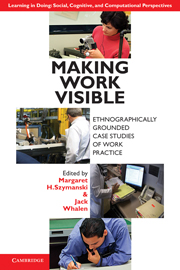Book contents
- Frontmatter
- Contents
- List of Figures and Excerpts
- List of Tables
- List of Contributors
- Series Foreword
- Foreword by John Seely Brown
- Acknowledgments
- Introduction
- Part I Work Practice Study in Historical Context
- Part II Applying Work Practice Methods
- Part III Practices around Documents
- Part IV The Customer Front
- 10 Integrated Customer Service
- 11 Interactions at a Reprographics Store
- 12 Ethnographically Informed Technology for Remote Help-giving
- 13 Sign of the Times at the Department Store
- Part V Learning and Knowledge Sharing
- Part VI Competency Transfer
- References
- Index
- LEARNING IN DOING: SOCIAL, COGNITIVE AND COMPUTATIONAL PERSPECTIVES
12 - Ethnographically Informed Technology for Remote Help-giving
Published online by Cambridge University Press: 05 August 2012
- Frontmatter
- Contents
- List of Figures and Excerpts
- List of Tables
- List of Contributors
- Series Foreword
- Foreword by John Seely Brown
- Acknowledgments
- Introduction
- Part I Work Practice Study in Historical Context
- Part II Applying Work Practice Methods
- Part III Practices around Documents
- Part IV The Customer Front
- 10 Integrated Customer Service
- 11 Interactions at a Reprographics Store
- 12 Ethnographically Informed Technology for Remote Help-giving
- 13 Sign of the Times at the Department Store
- Part V Learning and Knowledge Sharing
- Part VI Competency Transfer
- References
- Index
- LEARNING IN DOING: SOCIAL, COGNITIVE AND COMPUTATIONAL PERSPECTIVES
Summary
Ethnomethodological ethnographies have played an important role in design since Suchman's (1987) seminal work revealed that the cognitive models used as a basis for system design failed to take into account situated use and thus could lead to systems behaviour, which was incomprehensible to users. Ethnomethodological ethnographies aim to reveal the situated accomplishment of action. This in turn makes the social organisation of action visible and available to design reasoning (Button, 2000). The idea is to enhance design by enabling designers and ethnographers to explore “the practical implications for design of the incarnate social organisation of human action and how it may be supported, automated, or enhanced by a system” (Crabtree et al., 2009).
The exact role to be played by ethnography has been subject to a long, and, at times heated, debate – whether used for advancing the research field of Computer Supported Cooperative Work (CSCW) or requirements engineering (e.g., Viller and Sommerville, 1999). However, there is a strong consensus that ethnographies provide invaluable insights into how the orderliness of work is achieved. As Schmidt put it:
“[to] understand how orderliness is accomplished in cooperative endeavors; we need to uncover the practices through which the myriad distributed and yet interdependent activities are meshed, aligned, integrated, because it is the very practices through which such orderliness is accomplished that must be supported”
(Schmidt, 2000).- Type
- Chapter
- Information
- Making Work VisibleEthnographically Grounded Case Studies of Work Practice, pp. 225 - 239Publisher: Cambridge University PressPrint publication year: 2011
- 1
- Cited by



